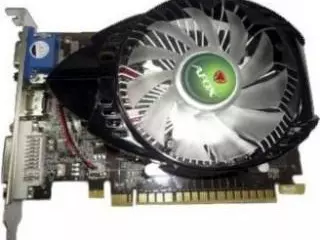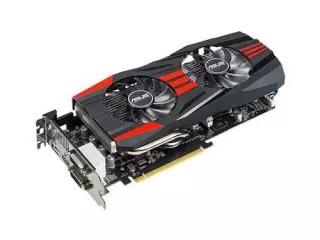GeForce GT 440 vs Radeon R9 270X
When choosing between GeForce GT 440 and Radeon R9 270X, it is worth examining the specifications of the models in detail. Do they meet the recommended requirements of modern games and software? Storage capacity, form factor, TDP, available ports, warranty and manufacturer support are all important. For example, the size of a PC case can limit the maximum thickness and length of the card. Often, instead of the factory overclocked card and RGB backlight, it is better to choose a reference model with a more efficient GPU. And make sure that your current power supply unit has the correct connection pins (using adapters is not recommended). This GPUs compare tool is meant to help you to choose the best graphics card for your build. Let's find out the difference between GeForce GT 440 and Radeon R9 270X.
Main Specs
GeForce GT 440
Radeon R9 270X
Power consumption (TDP)
65 Watt
180 Watt
Interface
PCIe 2.0 x16
PCIe 3.0 x16
Supplementary power connectors
None
2 x 6-pin
Memory type
DDR3
GDDR5
Maximum RAM amount
512 MB GDDR5 or 1 GB
2 GB
Display Connectors
1x DVI, 1x HDMI, 1x VGA
2x DVI, 1x HDMI, 1x DisplayPort
Check Price
Check Price
Radeon R9 270X has 176% more power consumption, than GeForce GT 440.
GeForce GT 440 is connected by PCIe 2.0 x16, and Radeon R9 270X uses PCIe 3.0 x16 interface.
GeForce GT 440 has 510 GB more memory, than Radeon R9 270X.
Both cards are used in Desktops.
GeForce GT 440 is build with Fermi architecture, and Radeon R9 270X - with GCN.
GeForce GT 440 is manufactured by 40 nm process technology, and Radeon R9 270X - by 28 nm process technology.
Game benchmarks
Assassin's Creed Odyssey
Battlefield 5
Call of Duty: Warzone
Counter-Strike: Global Offensive
Cyberpunk 2077
Dota 2
Far Cry 5
Fortnite
Forza Horizon 4
Grand Theft Auto V
Metro Exodus
Minecraft
PLAYERUNKNOWN'S BATTLEGROUNDS
Red Dead Redemption 2
The Witcher 3: Wild Hunt
World of Tanks
high / 1080p
0−1
24−27
ultra / 1080p
−
14−16
QHD / 1440p
0−1
10−11
4K / 2160p
−
6−7
low / 720p
1−2
45−50
medium / 1080p
0−1
30−35
The average gaming FPS of Radeon R9 270X in Assassin's Creed Odyssey is 4600% more, than GeForce GT 440.
high / 1080p
−
40−45
ultra / 1080p
−
30−35
QHD / 1440p
0−1
18−20
4K / 2160p
−
10−12
low / 720p
0−1
80−85
medium / 1080p
−
45−50
low / 768p
50−55
50−55
high / 1080p
45−50
−
QHD / 1440p
0−1
0−1
GeForce GT 440 and Radeon R9 270X have the same average FPS in Call of Duty: Warzone.
low / 768p
60−65
240−250
medium / 768p
27−30
210−220
ultra / 1080p
7−8
140−150
QHD / 1440p
−
110−120
4K / 2160p
−
60−65
high / 768p
16−18
180−190
The average gaming FPS of Radeon R9 270X in Counter-Strike: Global Offensive is 603% more, than GeForce GT 440.
low / 768p
70−75
60−65
ultra / 1080p
0−1
−
medium / 1080p
45−50
55−60
GeForce GT 440 and Radeon R9 270X have the same average FPS in Cyberpunk 2077.
low / 768p
45−50
120−130
medium / 768p
10−11
110−120
ultra / 1080p
0−1
90−95
The average gaming FPS of Radeon R9 270X in Dota 2 is 313% more, than GeForce GT 440.
high / 1080p
−
30−35
ultra / 1080p
−
27−30
QHD / 1440p
−
21−24
4K / 2160p
−
10−11
low / 720p
0−1
60−65
medium / 1080p
−
30−35
high / 1080p
−
40−45
ultra / 1080p
−
30−35
QHD / 1440p
−
18−20
low / 720p
21−24
140−150
medium / 1080p
0−1
85−90
The average gaming FPS of Radeon R9 270X in Fortnite is 559% more, than GeForce GT 440.
high / 1080p
0−1
40−45
ultra / 1080p
−
30−35
QHD / 1440p
0−1
18−20
4K / 2160p
−
16−18
low / 720p
0−1
80−85
medium / 1080p
0−1
45−50
low / 768p
18−20
110−120
medium / 768p
−
100−110
high / 1080p
0−1
50−55
ultra / 1080p
−
21−24
QHD / 1440p
0−1
10−12
medium / 720p
12−14
−
The average gaming FPS of Radeon R9 270X in Grand Theft Auto V is 505% more, than GeForce GT 440.
high / 1080p
−
16−18
ultra / 1080p
−
12−14
QHD / 1440p
−
12−14
4K / 2160p
−
4−5
low / 720p
0−1
45−50
medium / 1080p
−
21−24
low / 768p
75−80
120−130
high / 1080p
27−30
−
medium / 1080p
−
110−120
The average gaming FPS of Radeon R9 270X in Minecraft is 62% more, than GeForce GT 440.
ultra / 1080p
−
14−16
low / 720p
8−9
80−85
medium / 1080p
−
18−20
The average gaming FPS of Radeon R9 270X in PLAYERUNKNOWN'S BATTLEGROUNDS is 925% more, than GeForce GT 440.
high / 1080p
−
18−20
ultra / 1080p
−
12−14
QHD / 1440p
−
4−5
4K / 2160p
−
3−4
low / 720p
0−1
45−50
medium / 1080p
−
24−27
low / 768p
0−1
90−95
medium / 768p
−
55−60
high / 1080p
−
30−35
ultra / 1080p
−
18−20
4K / 2160p
−
10−11
low / 768p
45−50
90−95
medium / 768p
14−16
60−65
ultra / 1080p
0−1
45−50
high / 768p
12−14
55−60
The average gaming FPS of Radeon R9 270X in World of Tanks is 180% more, than GeForce GT 440.
Full Specs
GeForce GT 440
Radeon R9 270X
Architecture
Fermi
GCN
Code name
GF108
Curacao XT
Type
Desktop
Desktop
Release date
1 February 2011
8 October 2013
Pipelines
96
1280
Core clock speed
1620 MHz
Boost Clock
1050 MHz
Transistor count
585 million
2,800 million
Manufacturing process technology
40 nm
28 nm
Texture fill rate
13.0 billion/sec
84.00
Floating-point performance
311.04 gflops
2,688 gflops
Length
5.7" (14.5 cm)
Memory bus width
128 Bit
256 Bit
Memory clock speed
1600 MHz (GDDR5) or 900 MHz (DDR3)
Memory bandwidth
179.2 GB/s
Shared memory
-
DirectX
12 (11_0)
Shader Model
5.1
5.1
OpenGL
4.2
4.6
OpenCL
1.1
1.2
Vulkan
N/A
+
CUDA
+
FreeSync
+
CUDA cores
96
Bus support
PCI-E 2.0 x 16
PCIe 3.0
Height
4.376" (11.1 cm)
Multi monitor support
+
HDMI
+
+
Maximum VGA resolution
2048x1536
Audio input for HDMI
Internal
Bitcoin / BTC (SHA256)
20 Mh/s
318 Mh/s
Eyefinity
+
HD3D
+
TrueAudio
+
Design
reference
DisplayPort support
+
CrossFire
+
DDMA audio
+
Ethereum / ETH (DaggerHashimoto)
30 Mh/s
Zcash / ZEC (Equihash)
163 Sol/s
AppAcceleration
+
LiquidVR
+
TressFX
+
UVD
+
Standard memory config per GPU
1 GB GDDR5 or 2 GB
Check Price
Check Price

